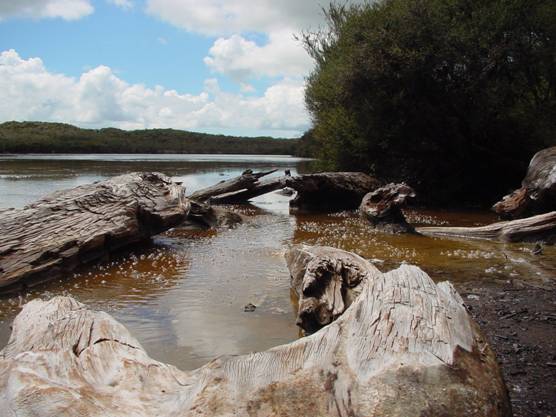13.3 What is the state of our geothermal resources?
There were several surveys of the Ngawha springs and the chemistry of their waters through the 1900s. For more detail on the findings refer to the geothermal resources chapter of the Regional Council's 2002 State of the Environment (SOE) report (NRC 2002b).
The resource consents granted for the power station in May 1994 required the joint venture to undertake at least 12 months of further baseline monitoring in the Ngawha area before it could start abstracting geothermal fluid. The joint venture collected more than 18 months of comprehensive data before the production wells were purged and commissioning of the power station began (Scott et al. 1998). For a summary of the key findings from that baseline monitoring refer to the ‘geothermal resources' chapter of the 2002 SOE report (NRC 2002b).

Lake Waiparaheka.
During the baseline monitoring period, a new species of mudfish, called Northland mudfish (Neochanna heleios), was discovered at two sites in Northland – near Kerikeri airport and in the Ngawha Catchment. It is an ephemeral wetland species and was considered to be critically endangered because of low numbers. A population of this mudfish species was found in one of the catchments immediately adjacent to the geothermal power station site, in the Department of Conservation (DOC) wetland below pond NG9.
Subsequent monitoring has identified a further area adjacent to the power plant, Bannister's Swamp, where the mudfish species has been discovered. However, mosquito fish (Gambusia affinis) have also been identified, which may provide a threat to the population in that area. The viability of the population resident in the DOC wetland below NG9 demonstrates the apparent resilience of this species to geothermal emissions.
One of the requirements of the 1994 consents was the development of a comprehensive programme to monitor the effects of the activities associated with the power station. This included monthly monitoring of the baths and other geothermal features in the area to determine any changes to the geochemistry and temperatures relative to baseline monitoring, and regular monitoring of selected locations considered representative of the receiving environment for the effects of any discharges from the power station operation. This receiving environment monitoring included the water quality of streams, the chemical composition of soil and plants and the biodiversity of selected sites within the area of influence of the power station activities. In addition, gas monitoring was undertaken to provide an ongoing assessment of concentrations.
Data from this monitoring was compared to baseline data and presented in six monthly reports. The reports were reviewed by a panel of experts in the respective fields, who made recommendations for any management or operational changes to the power station if required (NZE 1998 to present).
As part of the 2004 consent renewal and expansion applications all the data collected from the geothermal features and the receiving environment for discharges over the term of the existing consent was reviewed along with additional monitoring undertaken at the request of the Regional Council to provide further information for processing the consent. This review showed no significant variation in the geological and environmental features of the site relative to the baseline monitoring (Kingett Mitchell 2003; NRC 2004).
